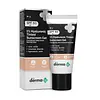What's inside
What's inside
 Key Ingredients
Key Ingredients

 Benefits
Benefits

 Concerns
Concerns

 Ingredients Side-by-side
Ingredients Side-by-side

Water
Skin ConditioningPropanediol
SolventButylene Glycol
HumectantEthylhexyl Methoxycinnamate
UV AbsorberOctocrylene
UV AbsorberAscorbyl Glucoside
AntioxidantButyl Methoxydibenzoylmethane
UV AbsorberDiethylamino Hydroxybenzoyl Hexyl Benzoate
UV FilterTitanium Dioxide
Cosmetic ColorantCentella Asiatica Extract
CleansingAscorbic Acid
AntioxidantSodium Hyaluronate
HumectantPanthenol
Skin ConditioningPolygonum Cuspidatum Root Extract
AntioxidantAmmonium Acryloyldimethyltaurate/Vp Copolymer
Dicaprylyl Carbonate
EmollientScutellaria Baicalensis Root Extract
AstringentGlycyrrhiza Glabra Root Extract
BleachingGold
Cosmetic ColorantDisodium EDTA
Pentapeptide-4
Skin ConditioningCamellia Sinensis Leaf Extract
AntimicrobialGlutathione
Chamomilla Recutita Flower Extract
MaskingPhenoxyethanol
PreservativeEthylhexylglycerin
Skin ConditioningSorbitol
HumectantRosmarinus Officinalis Leaf Extract
AntimicrobialWater, Propanediol, Butylene Glycol, Ethylhexyl Methoxycinnamate, Octocrylene, Ascorbyl Glucoside, Butyl Methoxydibenzoylmethane, Diethylamino Hydroxybenzoyl Hexyl Benzoate, Titanium Dioxide, Centella Asiatica Extract, Ascorbic Acid, Sodium Hyaluronate, Panthenol, Polygonum Cuspidatum Root Extract, Ammonium Acryloyldimethyltaurate/Vp Copolymer, Dicaprylyl Carbonate, Scutellaria Baicalensis Root Extract, Glycyrrhiza Glabra Root Extract, Gold, Disodium EDTA, Pentapeptide-4, Camellia Sinensis Leaf Extract, Glutathione, Chamomilla Recutita Flower Extract, Phenoxyethanol, Ethylhexylglycerin, Sorbitol, Rosmarinus Officinalis Leaf Extract
 Reviews
Reviews

Ingredients Explained
These ingredients are found in both products.
Ingredients higher up in an ingredient list are typically present in a larger amount.
Phenoxyethanol is a preservative that has germicide, antimicrobial, and aromatic properties. Studies show that phenoxyethanol can prevent microbial growth. By itself, it has a scent that is similar to that of a rose.
It's often used in formulations along with Caprylyl Glycol to preserve the shelf life of products.
Titanium dioxide is a mineral UV filter widely used in sunscreens and cosmetics.
It is one of only two UV filters officially classified as “mineral” by regulatory agencies, the other being zinc oxide.
Titanium dioxide provides broad-spectrum protection mostly in the UVB and UVAII range, with some protection in the UVAI range.
While its UVA protection isn’t as strong as zinc oxide’s, the difference is minor.
A common myth is that mineral UV filters reflect UV light. However, modern research shows titanium dioxide absorbs UV radiation like chemical filters (~95% absorption & 5% reflection).
Thanks to its non-irritating nature, titanium dioxide is suitable for sensitive, acne-prone, or redness-prone skin. It is unlikely to cause "eye sting" like other sunscreen ingredients.
A major drawback of this ingredient is its white cast and thick texture. This is why mineral sunscreens often leave a white cast and are less cosmetically elegant than chemical/hybrid sunscreens.
To improve white cast and spreadability, micronized or nano-sized titanium dioxide is often used.
There are ongoing concerns surrounding nano-titanium oxide's impact on marine ecosystems.
There is no conclusive evidence that any form of titanium oxide (or any other sunscreen ingredients) will cause harm to marine ecosystems or coral reefs. The science is still developing but many consumers are keeping a close eye on this issue.
Please note, many destinations have reef-safety sunscreen rules. For instance, the U.S. Virgin Islands advises all visitors to use non-nano mineral sunscreens.
Nano mineral sunscreens once raised safety concerns about absorption into skin.
Extensive research has shown that they do not penetrate healthy or damaged skin; they remain safely on the surface and the top layer of dead skin (stratum corneum).
You'll likely find titanium dioxide bundled with alumina, silica, or dimethicone. These ingredients help make titanium dioxide highly photostable; this prevents it from interacting with other formula components under UV light.
Learn more about Titanium Dioxide